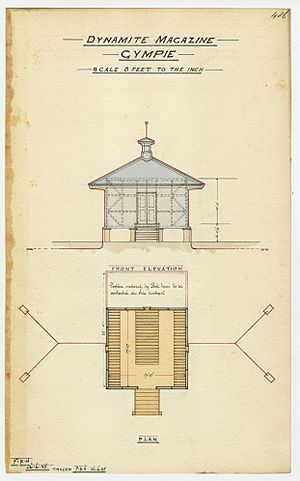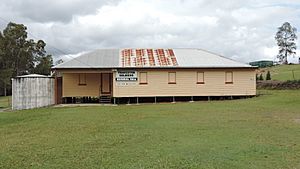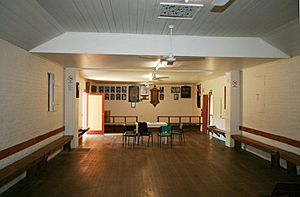Traveston Powder Magazine facts for kids
Quick facts for kids Traveston Powder Magazine |
|
|---|---|

Former Powder Magazine now part of Traveston Soldiers' Memorial Hall, 2009
|
|
| Location | 7 Traveston Road, Traveston, Gympie Region, Queensland, Australia |
| Design period | 1870s - 1890s (late 19th century) |
| Built | 1887 |
| Official name: Traveston Powder Magazine (former) (incorporated in Traveston Soldiers' Memorial Hall) | |
| Type | state heritage (built) |
| Designated | 10 June 2011 |
| Reference no. | 602783 |
| Significant period | 1887-1921, 1923-present |
| Significant components | memorial - honour board/ roll of honour |
| Builders | Queensland Department of Public Works |
| Lua error in Module:Location_map at line 420: attempt to index field 'wikibase' (a nil value). | |
The Traveston Powder Magazine is a special old building in Traveston, Queensland, Australia. It was built in 1887 to store explosives like gunpowder. Today, it's part of the Traveston Soldiers' Memorial Hall. This building is important because it shows us about the history of gold mining in Gympie and how communities remembered their soldiers after the World Wars. It was added to the Queensland Heritage Register on 10 June 2011.
Contents
What is a Powder Magazine?
A powder magazine is a strong, safe building used to store explosives, like gunpowder or dynamite. These buildings had to be very secure to prevent accidents. They were often built away from towns. This was to protect people if there was an explosion.
History of the Traveston Magazine
This magazine was first built in 1887 in Gympie, a town famous for gold mining. It was moved to Traveston in 1898. Later, in 1923, it became a hall to remember soldiers.
Gold Mining and Explosives
Gold was found in Gympie in 1867. This discovery helped Queensland a lot financially. At first, miners found gold near the surface. But soon, they had to dig deeper into rocks. This "deep reef mining" needed explosives to break up the hard rock.
The government controlled all explosives. They made sure these dangerous materials were stored safely. Special departments were in charge of building and managing magazines. These buildings had to be very strong. They often had small windows, thick walls, and special ventilation. They were also built with features to protect against lightning.
Gympie's Explosive Storage
Gympie had several magazines over time. The first one was built in 1868. But it wasn't big enough, and people worried about the explosives being too close to town. After an explosion in a store in 1877, people wanted a new, safer place for the explosives.
A new magazine was built in 1878. Then, in 1887, another brick magazine was added. This is the building that is now in Traveston. It had very thick walls and a special lightning conductor. Even with these safety features, some people still felt it was too close to Gympie.
Moving the Magazine to Traveston
In 1897, a small explosion from old explosives made people in Gympie even more worried. So, it was decided to move the magazines further away. Traveston, a small town south of Gympie, was chosen. The brick magazine and other buildings were moved there in 1898.
James Nash, who discovered gold in Gympie, was the magazine keeper. He and his daughter moved with the magazine to Traveston. After he retired, his daughter's husband took over. The magazines were placed near the railway line for easy transport of explosives.
From Magazine to Memorial Hall
By 1921, the magazines were no longer needed. The brick magazine was sold. However, the local community in Traveston had a different idea for it. After World War I (1914-1918), many communities wanted to build memorials for their soldiers.
In 1922, the people of Traveston decided to buy the brick magazine. They wanted to turn it into a Soldiers' Memorial Hall. This hall would be a place for the community and a way to remember those who served. Five local farmers bought the building for £5 each. In 1923, the land was officially set aside for the hall.
The building was used as a community hall between the World Wars. After World War II, more parts were added to the hall. The east wall of the old magazine was removed, and a timber section was added. A dining room was also built along the north side. Even with these changes, the original 1887 brick magazine walls and windows are still there.
What Does it Look Like Now?
The Traveston Powder Magazine is a rectangular brick building. It's now hidden behind the newer parts of the Traveston Soldiers' Memorial Hall. It has very thick brick walls and small, narrow windows. Inside, it has a polished timber floor and a special curved ceiling.
The newer parts of the hall are made of timber. Inside the hall, you can see three honour boards. These boards list the names of soldiers from the Traveston area who fought in World War I, World War II, and the Vietnam War. There are also portraits and plaques remembering these soldiers.
Why is it Important?
The former Traveston Powder Magazine is important for a few reasons:
- It shows us how gold mining worked in Gympie, especially the need for explosives.
- It's one of only a few government powder magazines from the 1800s still existing in Queensland.
- It's a great example of how these magazines were built.
- Its location near a railway line shows how explosives were moved and kept away from towns.
- Its use as a Soldiers' Memorial Hall shows how Australian communities honored their soldiers after the World Wars.




